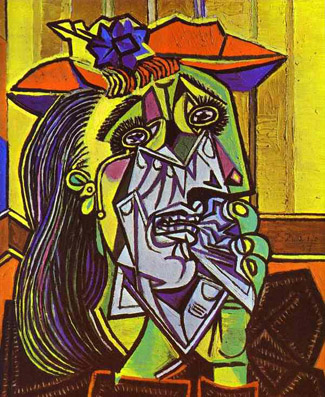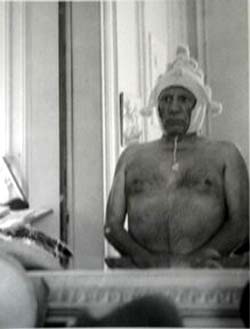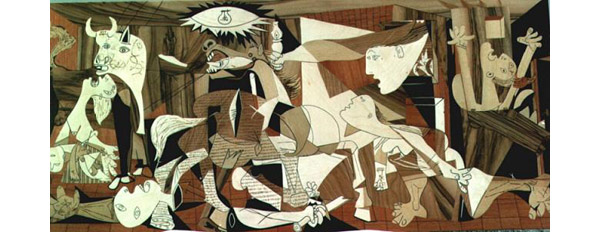 |
Art & Architecture
Picasso Painted in a State of Trance
Cunha Alvarenga
Among the so-called “masters” of modern art, Picasso enjoys a place of first importance. Besides being the creator of Cubism, his tumultuous spirit led him to participate in the most diverse styles and unbalanced schools of art. In each of these phases, his admirers as well as critics found ways to praise him and celebrate him. This is the case, for instance, of known English art critic, Sir Herbert Read (1893-1968). The English critic affirmed that “from his youth Picasso showed the prodigious infallibility of a genius.”
This same critic stated that in a certain phase of his artistic career, Picasso transferred the images of his subconscious to his canvas by painting in a state of trance. Read explained that this was not satire, since satire is an intellectual weapon and Picasso was not an intellectual artist, as he himself declared. Instead, he is an artist who, “by an intense concentration of his intuitive faculties, dove deep under the surface of his consciousness to explore the serenity of the collective subconscious.”

The Woman, from Picasso's cubist stage |
What was Picasso looking for in that tenebrous plunge into the “collective subconscious”? Read answered: “In this terrain we find the particular symptoms of the psychic disorders of society. These are the pains and conflicts of an indescriptible chaos that finds its outlet in the physical horrors of war and persecution. From this chaos Picasso took his disturbing images - images that are archetypes, specters of the dark forest where we all wander, where we lose ourselves unless we are saved by our forces of self-integration.”
All this seems quite confused, so let us put it in clearer words. Picasso is considered a genius, and as such infallible. He had the habit of painting in state of trance. In this condition he entered the deep layer of the collective subconscious. There he found the special symptoms of the psychic disorders of society. Those horrible images he painted in a state of trance are specters of the collective subconscious.
Picasso reflected on canvas the psychic disorders of society in such way that what for us appears to be a grotesque entanglement of lines, can supposedly become clearer if we also enter a trance state. Then we will see that those lines actually express “the pains and conflicts of an indescriptible chaos that finds its outlet in the physical horror of war and persecution.”
What did Picasso himself think about all this? The answer is given to us by Giovanni Papini, the same author of Gog and Magog, in an imaginary interview with the creator of Cubism in The Black Book [Il libro nero]. We will transcribe only its final part. Papini ironically attributes the following “confession” to Picasso, who supposedly paints in words his own portrait here:

Picasso, the charlatan |
“Little by little the new generations - passionate about mechanics and sports, increasingly frank, cynical and brutal - will abandon the art in museums and libraries as incomprehensible and useless relics of the past.
“What can an artist like me, who clearly sees this approaching time, do? It would be too hard to change professions and jeopardize putting food on the table. To him only two paths are open: to try to have fun and make money.
“Since art is no longer what inspires the best of society, the artist can try whatever he wants in new formulas, caprices of fantasy and intellectual charlatanism.
“People no longer look for consolation or exaltation in art. However, those with delicate sensibilities, the wealthy, the vagabonds and those who produce the quintessence of goods - fashions, perfumes, jewelry, luxury cars, watches, etc. - are still seeking the new, strange, original, extravagant and scandalous things. In Cubism I satisfied these persons and critics with all the mutating bizarre things that occurred to me, and insofar as they could not understand me, they admired me. As I diverted myself with these hoaxes, acrobatics of lines, puzzles, arabesques and rebus, I quickly became a celebrity. Celebrity for a painter means sales, profit, fortunes and wealth. Today, as you know, I am famous and wealthy.
“But when I am alone facing myself, I do not have the courage to consider myself an artist in the grand old meaning of the word. The true painters were Giotto and Titian, Rembrandt and Goya. I am just the public’s entertainer, who understood his time and exploited as much as possible the imbecility, vanity and cupidity of his contemporaries. This is a bitter confession, more painful than it may appear, but it has the merit of being sincere.”
This imaginary self-portrait seems to us quite faithful. But if it were truly a confession by Picasso, it would need to be more explicit to be really sincere. His pictures are not just acrobatics and extravagances to satisfy the depraved taste of the epoch. They have much of diabolical in them. Even had he not painted in a trance state and in communication with the Devil, he communicated to us a demonic agitation and ugliness.
This would not exclude that he was also a charlatan, since the Devil is the father of the lie.

Picasso's famous Guernica [War] expresses his chaotic and revolutionary state of mind
|

Published in Catolicismo, n. 21, September 1952
Translated and adapted by TIA desk
Posted November 16, 2011

Related Topics of Interest
 The Modern Art's Kabala The Modern Art's Kabala
 A Sacred Art Possesed by the Devil A Sacred Art Possesed by the Devil
 Esoteric Characteristics of Modern Art Esoteric Characteristics of Modern Art
 Abstract Art & Theosophy Abstract Art & Theosophy
 Modern Art, Socialism & Marxism Modern Art, Socialism & Marxism
 Two Pictures, Two Mentalities, Two Doctrines Two Pictures, Two Mentalities, Two Doctrines
 Picasso-style Panel in Austrian Church Picasso-style Panel in Austrian Church
 Gog's Era of the Child Has Come Gog's Era of the Child Has Come

Related Works of Interest
|
|
Art & Architecture | Hot Topics | Home | Books | CDs | Search | Contact Us | Donate

© 2002-
Tradition in Action, Inc. All Rights Reserved
|
 |

|